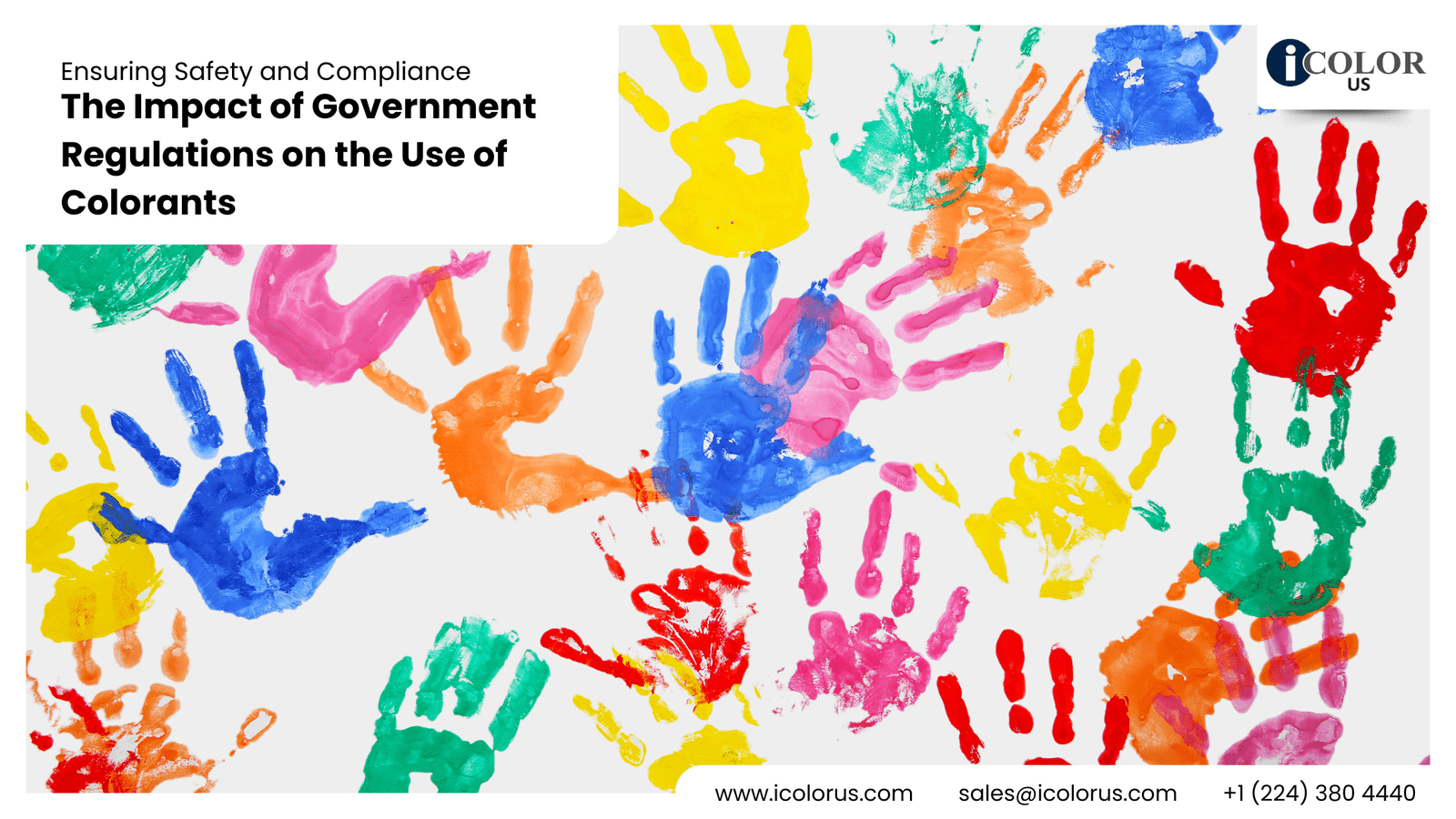Impact of Government Regulations on the Use of Colorants
- Introduction
- Overview of Colorants
- Importance of Colorants in Various Industries
- Brief on Government Regulations
- Historical Background of Colorant Regulations
- Early Use of Colorants
- Initial Regulatory Efforts
- Evolution Over Time
- Types of Colorants and Their Applications
- Natural Colorants
- Synthetic Colorants
- Applications in Food
- Applications in Cosmetics
- Applications in Textiles
- Applications in Pharmaceuticals
- Key Government Bodies Regulating Colorants
- FDA (Food and Drug Administration)
- EPA (Environmental Protection Agency)
- European Food Safety Authority (EFSA)
- Other International Regulatory Bodies
- Major Regulations Governing Colorants
- Food Safety Regulations
- Cosmetic Safety Regulations
- Environmental Regulations
- Textile Industry Regulations
- Pharmaceutical Regulations
- Impact on the Food Industry
- Approved vs. Banned Colorants
- Labeling Requirements
- Consumer Safety and Health Concerns
- Impact on the Cosmetic Industry
- Safety Testing Requirements
- Labeling and Disclosure Requirements
- Banned Substances
- Impact on the Textile Industry
- Environmental Impact
- Worker Safety Regulations
- Sustainable Practices
- Impact on the Pharmaceutical Industry
- Safety and Efficacy Testing
- Labeling Standards
- Colorant Additive Restrictions
- Challenges Faced by Manufacturers
- Compliance Costs
- R&D for Safe Alternatives
- Global Compliance Variations
- Consumer Perspectives and Preferences
- Shift Towards Natural Colorants
- Impact of Health Trends
- Public Awareness Campaigns
- Innovations in the Colorant Industry
- Development of Safe Synthetic Colorants
- Advancements in Natural Colorant Extraction
- Technological Innovations
- Case Studies
- Successful Compliance in the Food Industry
- Innovations in Cosmetic Colorants
- Sustainable Practices in the Textile Industry
- Future Trends in Colorant Regulations
- Increasing Stringency
- Global Harmonization Efforts
- The Role of Scientific Advancements
- Conclusion
- Summary of Key Points
- The Balance Between Safety and Innovation
- The Ongoing Evolution of Regulations
- FAQs
- Why are colorants regulated?
- What are the differences between natural and synthetic colorants?
- How do regulations impact small manufacturers?
- What are the potential health risks associated with colorants?
- How can consumers ensure the safety of colorants in products?
The Impact of Government Regulations on the Use of Colorants
Introduction
Colorants are everywhere—from the bright hues in your food and cosmetics to the vibrant fabrics in your clothes. They play a crucial role in various industries, enhancing the appeal and functionality of countless products. But with great color comes great responsibility, particularly concerning safety and environmental impact. This is where government regulations come in, ensuring that the use of colorants does not pose risks to consumers or the environment.
Historical Background of Colorant Regulations
Early Use of Colorants
The use of colorants dates back to ancient civilizations, where natural dyes were derived from plants, minerals, and insects. These early colorants were used in everything from textiles to cosmetics and food.
Initial Regulatory Efforts
As industrialization progressed, the development of synthetic colorants began, leading to increased use and exposure. Initial regulatory efforts focused on preventing obvious health hazards, such as toxic additives in food and cosmetics.
Evolution Over Time
Over the years, regulatory frameworks have evolved, becoming more comprehensive and stringent. This evolution reflects growing scientific knowledge about the potential health and environmental impacts of various colorants.
Types of Colorants and Their Applications
Natural Colorants
Natural colorants are derived from plant, animal, or mineral sources. Examples include beet juice (red), turmeric (yellow), and cochineal (red from insects). These are often perceived as safer and more environmentally friendly.
Synthetic Colorants
Synthetic colorants are man-made and include a wide range of chemical compounds. They offer vibrant colors and consistency but can pose health risks if not properly regulated.
Applications in Food
Colorants are used in food to enhance appearance and appeal. They are found in candies, beverages, and processed foods, where they make products more attractive.
Applications in Cosmetics
In cosmetics, colorants are essential for products like lipsticks, eyeshadows, and hair dyes. Safety regulations ensure that these products do not cause adverse health effects.
Applications in Textiles
Textile colorants are used to dye fabrics, giving clothes their vibrant colors. Regulations focus on environmental impact and worker safety in the dyeing process.
Applications in Pharmaceuticals
Colorants in pharmaceuticals help in product identification and patient compliance. They must meet stringent safety standards to avoid adverse reactions.
Key Government Bodies Regulating Colorants
FDA (Food and Drug Administration)
The FDA regulates colorants used in food, drugs, and cosmetics in the United States. It ensures that these substances are safe for consumption and use.
EPA (Environmental Protection Agency)
The EPA focuses on the environmental impact of colorants, particularly in industries like textiles and manufacturing, ensuring that the use and disposal of these substances do not harm the environment.
European Food Safety Authority (EFSA)
In Europe, the EFSA regulates colorants, particularly those used in food, to protect consumer health. It conducts risk assessments and provides scientific advice.
Other International Regulatory Bodies
Various other countries have their regulatory bodies, such as Health Canada and the Australian Therapeutic Goods Administration (TGA), which oversee the use of colorants in their respective regions.
Major Regulations Governing Colorants
Food Safety Regulations
Regulations ensure that food colorants do not pose health risks. This includes approved lists of safe colorants and strict limits on their usage.
Cosmetic Safety Regulations
Cosmetic regulations require safety testing and labeling of colorants to prevent adverse health effects from products applied to the skin or hair.
Environmental Regulations
Environmental regulations focus on the impact of colorant production and disposal, promoting sustainable practices to minimize pollution.
Textile Industry Regulations
In the textile industry, regulations ensure that dyes do not harm workers or the environment, promoting the use of safer alternatives and waste management practices.
Pharmaceutical Regulations
Pharmaceutical regulations require thorough testing of colorants to ensure they do not interfere with the safety and efficacy of medications.
Impact on the Food Industry
Approved vs. Banned Colorants
Regulatory bodies maintain lists of approved and banned colorants based on safety assessments. This ensures that only safe substances are used in food products.
Labeling Requirements
Food products must clearly label colorants, allowing consumers to make informed choices and avoid potential allergens.
Consumer Safety and Health Concerns
Strict regulations protect consumers from harmful substances, addressing health concerns such as hyperactivity in children and potential carcinogenic effects.
Impact on the Cosmetic Industry
Safety Testing Requirements
Colorants in cosmetics undergo rigorous testing to ensure they do not cause skin irritation, allergies, or other health issues.
Labeling and Disclosure Requirements
Cosmetic products must disclose all colorants used, enabling consumers to avoid substances they may be sensitive to.
Banned Substances
Certain harmful colorants are banned from use in cosmetics, protecting consumers from potential health risks.
Impact on the Textile Industry
Environmental Impact
Textile dyeing can have significant environmental impacts, including water pollution and chemical waste. Regulations promote the use of eco-friendly dyes and waste treatment practices.
Worker Safety Regulations
Ensuring the safety of workers handling dyes is crucial. Regulations enforce the use of protective gear and safe handling practices to prevent occupational hazards.
Sustainable Practices
The push for sustainability has led to the development of greener dyeing methods and the use of natural dyes, reducing the industry’s environmental footprint.
Impact on the Pharmaceutical Industry
Safety and Efficacy Testing
Colorants in pharmaceuticals are tested for safety and efficacy to ensure they do not interfere with the drug’s therapeutic effects or cause adverse reactions.
Labeling Standards
Pharmaceutical products must label all colorants used, aiding in product identification and ensuring patient safety.
Colorant Additive Restrictions
Strict regulations limit the use of certain colorants in medications to protect patient health.
Challenges Faced by Manufacturers
Compliance Costs
Meeting regulatory standards can be costly for manufacturers, involving extensive testing, reformulation, and labeling changes.
R&D for Safe Alternatives
Research and development of safe and effective alternatives to harmful colorants require significant investment and innovation.
Global Compliance Variations
Manufacturers must navigate varying regulations across different countries, complicating international trade and product formulation.
Consumer Perspectives and Preferences
Shift Towards Natural Colorants
Increasing health and environmental awareness have led to a consumer shift towards natural colorants, perceived as safer and more sustainable.
Impact of Health Trends
Health trends influence consumer preferences, with more people seeking products free from synthetic additives and potential allergens.
Public Awareness Campaigns
Campaigns educating the public about the safety and environmental impact of colorants have raised awareness and influenced purchasing decisions.
Innovations in the Colorant Industry
Development of Safe Synthetic Colorants
Advancements in chemistry have led to the development of safer synthetic colorants that meet regulatory standards and consumer expectations.
Advancements in Natural Colorant Extraction
Improved extraction techniques have enhanced the viability of natural colorants, making them more accessible and cost-effective.
Technological Innovations
Technological innovations in colorant production and application have improved safety, efficiency, and sustainability across industries.
Case Studies
Successful Compliance in the Food Industry
Companies that have successfully navigated regulatory requirements demonstrate how compliance can be achieved without compromising product quality.
Innovations in Cosmetic Colorants
Cosmetic companies leading in innovation show how safe and vibrant colorants can be developed, setting industry benchmarks.
Sustainable Practices in the Textile Industry
Textile companies adopting sustainable dyeing practices highlight the benefits of eco-friendly approaches and regulatory compliance.
Future Trends in Colorant Regulations
Increasing Stringency
Regulations are expected to become more stringent, reflecting growing scientific knowledge and public health concerns.
Global Harmonization Efforts
Efforts to harmonize regulations globally aim to simplify compliance for manufacturers and ensure consistent safety standards.
The Role of Scientific Advancements
Ongoing scientific advancements will continue to shape regulations, promoting the development of safer and more effective colorants.
Conclusion
Government regulations play a vital role in ensuring the safe use of colorants across various industries. While they pose challenges for manufacturers, they also drive innovation and protect consumer health and the environment. Balancing safety with innovation is key to the ongoing evolution of colorant regulations, ensuring a safer and more sustainable future.
FAQs
Why are colorants regulated?
Colorants are regulated to ensure they do not pose health risks to consumers or cause environmental harm. Regulations establish safety standards and prevent the use of harmful substances.
What are the differences between natural and synthetic colorants?
Natural colorants are derived from natural sources like plants and minerals, while synthetic colorants are man-made. Natural colorants are often perceived as safer and more environmentally friendly.
How do regulations impact small manufacturers?
Regulations can be challenging for small manufacturers due to the costs of compliance, including testing and reformulation. However, they also ensure product safety and consumer trust.
What are the potential health risks associated with colorants?
Some colorants, particularly synthetic ones, can cause health issues like allergies, hyperactivity in children, and potential carcinogenic effects if not properly regulated.
How can consumers ensure the safety of colorants in products?
Consumers can ensure safety by checking product labels for approved colorants, staying informed about potential risks, and choosing products from reputable manufacturers that comply with regulatory standards.





